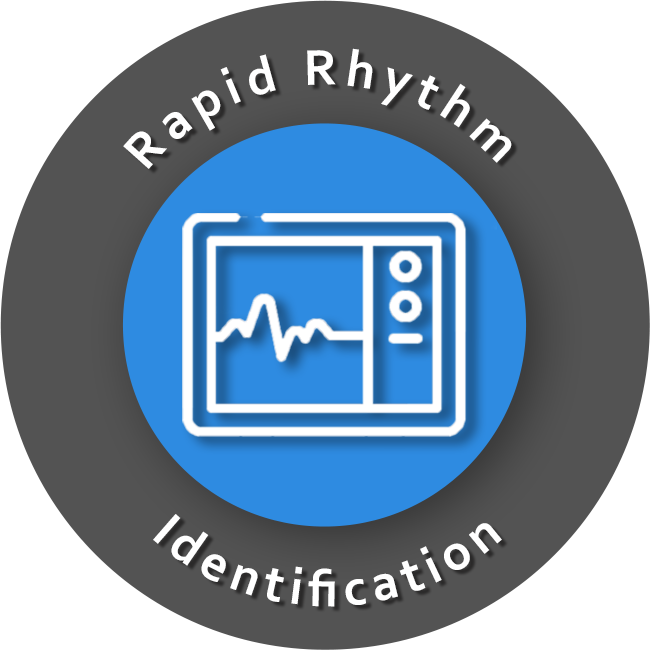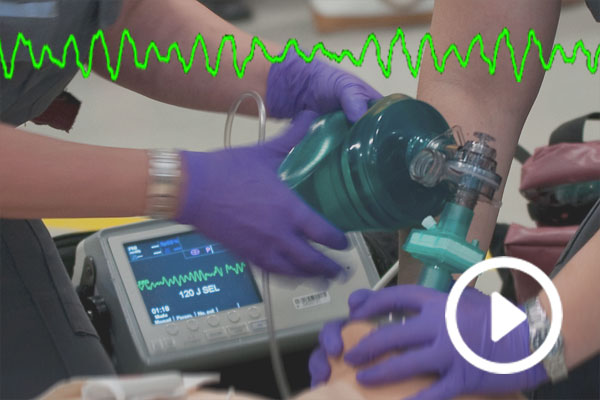
Rapid rhythm identification is an essential part of ACLS, and providers must have the ability to recognize and treat all of the most common rhythms that occur during emergency situations. The videos provided in the Rapid Rhythm Identification Library are practice tools to help you become comfortable with identifying all of the major rhythms that are treated using the ACLS protocol. Each video contains rhythms that you must identify and random questions about ECG rhythms and their treatment. These videos are designed to prepare you for ACLS certification and also for real-world situations.
Before watching a rapid rhythm identification video, you may want to prepare by reviewing the pages on ECG rhythm interpretation.



Ljlehrl says
I think that you should have additional rhythm review sequences!
kari says
have my certification the next two days…… thanks much in part to you, i think i’m ready!!
c17pilotsmom says
my favorite section so far…more videos please
rzinder says
Very helpful website. Your ACLS Algorithm Video Reviews and Megacode Simulator Quizzes are simply EXCELLENT!!!!!!!
THANK YOU!!!!
nicksavage says
Very nice site, you and your brother put quite a bit of work in this, and I do appreciate it.
Thank you for the hard work.
YGREMI says
Jeff,
I’m up for re-cert tomorrow. Class 1st day then test 2nd day. I wish I had found this before yesterday. It is so helpful and user friendly. Boosted my confidence way up. I do need to boost up on strip identication and measurements. Is there a site I can go to that reviews basic strip measurements and test strips?
Again, thank you. You have done such a great job with this site. I wish you were my instructor!
Thanks, Gaby
Jeff with admin. says
This site should be of help: Basic 12-Lead interpretation.
Although, it is designed for 12-Lead interpretation, and will be more than is necessary for ACLS, it is straight to the point and self-paced.
Kind regards,
Jeff
Phil says
Jeff,
What actually is happening in the heart during depolarization and repolarization? Im a bit confuse about it .
Thanks.
V/ R Phil
Jeff with admin. says
When you look at an ECG strip or a monitor with the ECG displayed. You see the following P-wave, PR-interval, QRS Complex, ST-segment, and T-wave:
First, the p-wave which represents electrical depolarization of the SA node and consequent atrial contraction.
Second the PR-interval is a critical delay in the conduction system at the AV node that allows the atria to fully contract before the electrical impulse proceeds to make the ventricles contract;
Third, the QRS Complex represents electrical depolarization of the ventricles and consequent contraction of the ventricular muscle.
Fourth the ST-segment and the T-wave which represent repolarization of the ventricles. Repolarization restores the ventricles to negative charge which readies the myocardium for another depolarization and subsequent contraction.
If you are a visual learner, these two videos will help clarify:
Electrical System of the Heart (9min 43 seconds long)
Depolarization of the Heart (11min 44 seconds long)
Kind regards,
Jeff
kathya says
could you explain wide and narrow complexes?
Jeff with admin. says
Wide QRS Complex usually means that the electrical impulses are usually ventricular in origin. This is true for both bradycardia and tachycardia. With bradycardia it occurs as an ventricular escape rhythm because of a blocked electrical conduction. With tachycardia the wide QRS complex is usually related to an arrhythmia that is producing an electrical conduction that is generated in the ventricles.
Narrow QRS Complex usually means that the electrical conduction was generated above the level of the AV node.
Kind regards,
Jeff
elmer says
Excellent ! Highly recommended. Thanks.
mark glover says
with a first degree heart block, and a second degree type II block, should atropine be used if the Pt. has bradycardia?
Jeff with admin. says
If the patient has symptomatic bradycardia then atropine can be used. With 2nd degree block type 2, you would want to use it cautiously due to the fact that MI can cause 2nd degree block type 2. In the case of MI the use of atropine could worsen the ischemia. In this case TCP or the use of a titrated epinephrine or dopamine drip would be a better choice.
Kind regards,
Jeff
Nunu09 says
Hi Jeff,
I would like a more in depth explanation of the heart blocks like how to recognize 1st, 2nd and 3rd degree heart blocks and what to do for each of them. Also, is defebrillation the same as shock? One one thing, thanks to your site I passed my ACLS but there weren’t any questions from my ACLS test on the actual ACLS test. I really would benefit from what I call the KISS (keep it simple stupid) format. I would like a more dummy done version of what to do for the more lethal rhythms. I’d really appreciate your help…you already have been a great resource. Keep up the great work!
Jeff with admin. says
Thanks for the feedback. I want to let you know that there are specific pages about each of the rhythms that you mentioned. I have listed the links below. I try to keep the information as simple as possible as I have a wide range of skill levels of people who subscribe.
I hope these help you.
1st degree heart block
2nd degree heart block type 1
2nd degree heart block type 2
3nd degree heart block type (complete block)
Two most lethal rhythms:
Pulseless Ventricular Tachycardia
Ventricular Fibrillation
Kind regards, Jeff
lukasocias says
Hey Jeff, should atropine still be given (while preparing transcutaneous pacing) in symptomatic third degree heart block if you suspect it to be caused by ischemic heart disease? Or should you skip straight to TP? Thanks!
Jeff with admin. says
If you suspect ischemia, it would be wise to skip atropine and go to TCP. Keep the pacing at around 50-60/min. You do not want to increase myocardial oxygen consumption. When you give atropine, this can increase the heart rate to the point of myocardial oxygen demand which can worsen ischemia. —-Kind regards, Jeff
cheche30 says
hello jeff, I got confuse with atrial flutter and atrial fibrilation. Is there any thing that are so distinct between the two? that I could tell right away the difference? thanks
Jeff with admin. says
Yes. For atrial flutter will often have a sawtooth pattern and you will see very distinct extra P-waves on the tracing between the QRS waveform.
For atrial fibrillation remember: no p-waves at all and an irregular heart rate. (irregular heart rate is indicated by changing distances between each QRS waveform.
I hope this makes sense. Kind regards, Jeff
John says
I think of it like this. The “Flutter” looks like a shark fin. You flutter kick in the water and sharks are in the water (normally). So sharkfin=flutter.
Melvina Coles says
Awesome site. The practice tests were very helpful. I did the ACLS exam Yesterday and passed with flying colors! Some of the questions found here were VERY similar to those on the actual test. The videos and megacode simulations were excellent too. Very helpful. A MILLION THANKS!!!
I, to appreciate all the work and time you put into making this such a great learning tool. Perfect !
Best regards Mr. Jeff
Connie Brandl says
Jeff & Chris
I feel very prepared for my ACLS recert tomorrow thanks to the practice scenarios, test questions and videos you’ve provided. This site is a great adjunct to the AHA material provided by my employer. Thank you for this site- I’ve been recommending it to my co-workers who will be re-certifying in the coming months.